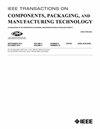A High-Voltage Low-Dropout Regulator With Wide Ranges of Output Capacitance and Au80Sn20 Alloy Solder for Packaging
IF 2.3
3区 工程技术
Q2 ENGINEERING, ELECTRICAL & ELECTRONIC
IEEE Transactions on Components, Packaging and Manufacturing Technology
Pub Date : 2025-02-26
DOI:10.1109/TCPMT.2025.3546032
引用次数: 0
Abstract
This article presents the circuit design and the implementation of a low-dropout (LDO) regulator with high-voltage operation across a broad temperature range from一种具有宽范围输出电容和 Au80Sn20 合金焊料的高压低压差稳压器,适用于封装
本文介绍了一种低压差(LDO)稳压器的电路设计和实现方法,该稳压器可在从 $- 55~^{\circ }$ 到 $125~^{\circ }$ 的宽温度范围内实现高电压工作。{\mathrm {C}}$ 至 $125~^{\circ }。{\mathrm {C}}$ 。建议的 LDO 可在输出电容 $C\rm _{OUT}$ (从 1 到 $100~\mu $ F)和有效串联电阻(ESR;从几十毫欧的陶瓷电容器到几欧的铝电解电容器)的宽范围内稳定运行。该 LDO 消耗的静态电流不超过 200- $\mu $A。这种低静态电流是通过用 p 型横向扩散 MOS(LDMOS)替代传统的高压 p-n-p 双极功率晶体管获得的,从而将静态电流从几十毫安降低到几百微安。与此同时,p 型 LDMOS 功率晶体管的大型栅极电容导致的瞬态响应劣化问题也通过具有专门设计的反馈路径、AB 类双极驱动器和动态偏置的运算放大器得到了缓解。测量结果表明,当负载电流在 3~\mu \text {s}$ 内从 5 mA 跳至 750 mA 时,输出电压过冲保持在 50 mV 以下,输出电容为 $C\rm _{OUT}$ $1~\mu$F。
本文章由计算机程序翻译,如有差异,请以英文原文为准。
求助全文
约1分钟内获得全文
求助全文
来源期刊

IEEE Transactions on Components, Packaging and Manufacturing Technology
ENGINEERING, MANUFACTURING-ENGINEERING, ELECTRICAL & ELECTRONIC
CiteScore
4.70
自引率
13.60%
发文量
203
审稿时长
3 months
期刊介绍:
IEEE Transactions on Components, Packaging, and Manufacturing Technology publishes research and application articles on modeling, design, building blocks, technical infrastructure, and analysis underpinning electronic, photonic and MEMS packaging, in addition to new developments in passive components, electrical contacts and connectors, thermal management, and device reliability; as well as the manufacture of electronics parts and assemblies, with broad coverage of design, factory modeling, assembly methods, quality, product robustness, and design-for-environment.
 求助内容:
求助内容: 应助结果提醒方式:
应助结果提醒方式:


